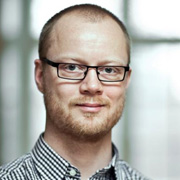Klaus tells us about the course: Digital Services Innovation.
Academic background brought into play and new disciplines developed
The course is designed for students with diverse educational backgrounds and uses “digital services” (in healthcare) as the integrating component. Students learn new skills and competencies related to the design of digital services while being able to apply their academic knowledge. For example, Computer Science students have knowledge of digital services in general, IT & Health students have knowledge about health informatics, students from DTU Design and Innovation have knowledge about innovation processes, and CBS students have knowledge about businesses. In order to handle the students’ interdisciplinary group work, they are divided into groups, from a perspective of balancing their educational background, institutional background and learning style. However, it can create challenges as Klaus Marius Hansen explains:
“We therefore try to have students with both a technical and non-technical background in each group. Our experience shows us, that it is especially important that there is an appropriate balance of educational backgrounds represented in the individual groups”.
The course includes presentations on methods (eg. Design interventions) and the problem domain (eg. Digital services in the health sector). We expect the students to acquire innovation and entrepreneurial skills by completing the course. The digital service innovation project that the students work on is essential in achieving these competencies. The project is also the basis for the written report and the oral examination that is used in the assessment.
Case collaborations with companies is the focal point
On the course, students work with cases that are defined by organizations or companies that formulate a problem that can be investigated and supported through digital services. When students have a case, they must first analyze the problem, then design possible solutions, and evaluate these – in a process where they involve stakeholders and end-users.
In total, seven organizations or companies have been involved in three courses of Digital Services Innovation. For example, the Danish College of General Practitioners asked a group of students to create solutions for supporting palliative care with smartphone apps. When the groups work on the case study, they receive mentoring along the way, and the groups present their projects in a plenary session, where they receive feedback.
An iterative approach to innovation challenges the students
“The innovation approach can best be described as a prototyping process in which a series of prototypes of the digital service are produced. To do this, we use a mix of techniques including ethnographic fieldwork, user involvement, design interventions, paper prototyping, functional prototyping, and business modeling” says Klaus Marius Hansen.
On the course Digital Services Innovation an iterative and spiral approach to innovation is selected, rather than a clear divergent/convergent approach, as represented by for example the Herzberg or double diamond process model. The projects move students quickly through a number of design cycles, where they explore different aspects of their project. This approach challenges the students’ ability to quickly switch between divergent and convergent thinking ways.
Klaus Marius Hansen explains: “A design cycle requires that the students are able to narrow down what they want to explore during a cycle (convergent thinking), plan and conduct a short study intervention (eg. Internet searches, interviewing a use or perform a design experiment), and explore how the outcome affects their design (divergent thinking). Our experience shows us that many students, especially early in the projects, find it difficult to converge their projects. “
